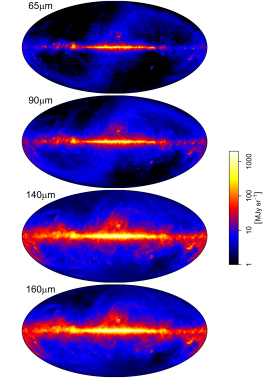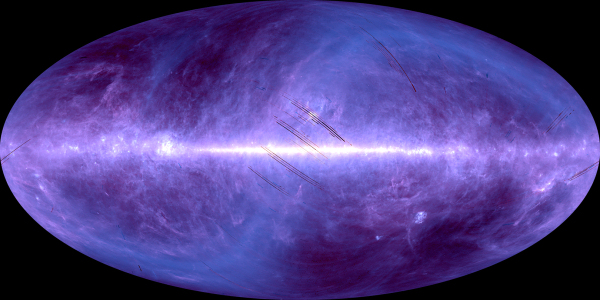AKARI far-infrared all-sky data released
4 May 2015
The AKARI space telescope's far-infrared all-sky image data are now available to researchers everywhere. The new all-sky maps have four to five times better spatial resolution than conventional far-infrared all-sky images, and include data at longer wavelengths.AKARI, formerly known as ASTRO-F, is the second space mission for infrared astronomy from the Institute of Space and Astronautical Science (ISAS) of the Japanese Aerospace Exploration Agency (JAXA). It was realised with ESA participation.
AKARI's main objective was to perform an all-sky survey with better sensitivity, spatial resolution and wider wavelength coverage than IRAS, the Infrared Astronomical Satellite (IRAS) launched on 25 January 1983.
Although having been launched more than 30 years ago, the IRAS all-sky maps are still a standard resource for modern astronomers. Now, AKARI's maps improve on IRAS by a factor of four or five.
AKARI was launched on 21 February 2006. To achieve the sensitivity needed to make its maps, the telescope's detector had to be cooled to -271°C. Because the spacecraft could only carry 170 litres of coolant, this meant it had a limited lifetime.
 |
| AKARI all-sky images: 65, 90, 140 and 160 micrometres. Credit: JAXA |
During its 'cold' lifetime of 550 days it conducted the all-sky survey, observing more than 99% of the entire sky, with 1 to 1.5 arcminute resolution, in four wavelengths: 65, 90, 140 and 160 micrometers. This provides an excellent scientific legacy because these data also provide photometric information for about half a million sources.
Far-infrared light is the key wavelength range for investigating the formation of stars and planetary systems. It is emitted mostly from low-temperature dust and so reveals the distribution of the interstellar medium, as well as the processes of star formation within it.
In addition, the observations of various galaxies at far-infrared wavelengths allow scientists to explore the history of star formation in the Universe. Furthermore, closer examination of the distribution of the interstellar medium allows scientists to measure precisely cosmic background radiation, which is essential to investigate the origin of the Universe.
By combining AKARI data with data from ESA's other infrared space telescopes, ISO and Herschel, scientists can also look for variability in celestial sources.
The PACS instrument on Herschel covers a similar wavelength region to AKARI and achieved a greater spatial resolution in its observations. However, PACS was not designed to study the whole sky: it has observed some 7% of the sky at wavelengths of 70, 100 and 160 micrometers, compared with AKARI's 99% coverage, underlining how useful the new AKARI data will be.
The AKARI far-infrared all-sky image maps have been calibrated and prepared for public release by the research group of Dr Yasuo Doi, Assistant Professor at the Graduate School of Arts and Sciences, the University of Tokyo, and collaborators at the Institute of Space and Astronautical Science/JAXA, Tohoku University, University of Tsukuba, Rutherford Appleton Laboratory and the Open University (UK).
The full data sets can be accessed at http://www.ir.isas.jaxa.jp/AKARI/Archive/Images/FIS_AllSkyMap/
More information
AKARI is a JAXA project with the participation of ESA. Development of the satellite and instruments, operation, and data reduction have been carried out in collaboration with the following institutes; Nagoya University, University of Tokyo, National Astronomical Observatory Japan, Imperial College London, University of Sussex, Open University (UK), University of Groningen / SRON (The Netherlands), and Seoul National University (Korea). The far-infrared detectors were developed in collaboration with the National Institute of Information and Communications Technology, Japan.
ESA's European Space Operations Centre (ESOC) in Darmstadt, Germany, provided the mission with ground support through its ground station in Kiruna, Sweden, for several passes per day in the cold phase of the mission.
ESA's European Space Astronomy Centre (ESAC) near Madrid, Spain, provided support for the sky-survey data processing through the pointing reconstruction, which was essential for determining accurate astronomical positions for each of the sources detected. ESAC also provided user support for European astronomers who were granted 10% observing time from this collaboration.



